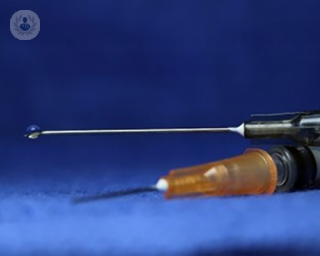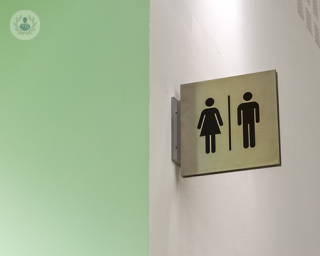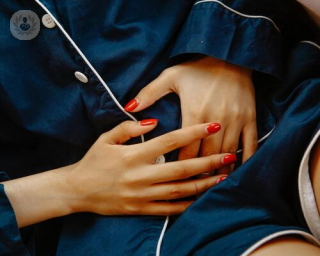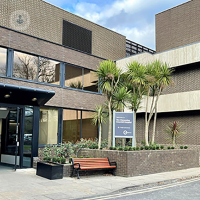What is urinary incontinence?
Urinary incontinence is the involuntary leaking of urine, and it occurs more often in women than in men. Some women may find a few drops of urine are let out while running, or coughing, while others may have a strong urge to urinate over a long period of time.

There are two main types of urinary incontinence: stress incontinence and urge incontinence.
The more common of the two is stress incontinence, which is said to affect up to one in every four women. Women's chances of experiencing stress incontinence increases if they have previously given birth. Stress incontinence is characterised by an involuntary loss of urine upon physical exercise or physical exertion.
Urge incontinence is less common, affecting roughly one in every 13 women, and is typically characterised by an intense urgency to pass urine and the inability to delay the passing of urine.
Mixed incontinence may be experienced by some women when they suffer from both loss of urine when physically exerting themselves and a desperate need to pass urine. This can occur in one in 20 women.
What are the main causes of urinary incontinence in women?
There are many causes of both stress incontinence and urge incontinence in women. The main causes of stress incontinence include:
- loss of pelvic floor ligament and muscle support
- loss of sphincter strength and support
The main cause of urge incontinence is overactive bladder syndrome.
What are the main risk factors for women?
The main risk factor is age. Unfortunately, the older women become, the more likely they are to experience urinary incontinence. In fact, research has shown that up to one in every two women over the age of 70 suffers from some form of urinary incontinence. Other risk factors include obesity, a family history of urinary incontinence, and previous vaginal birth.
How is urinary incontinence in women treated?
Firstly, there are many non-surgical methods of treating urinary incontinence in women that one's GP will advise to see if symptoms improve. These include the following:
- lifestyle changes, such as consuming less alcohol
- pelvic floor exercises (where a woman will learn how to strengthen her pelvic muscles by squeezing them)
- bladder training
- absorbent pads
- medicine
There are then a wide variety of different surgical options for both types of urinary incontinence in women. The main surgical procedures that can help treat stress incontinence include:
- colposuspension
- sling surgery
- vaginal mesh surgery (this is no longer recommended in the UK)
- urethra bulking agent
- artificial urinary sphincter
The main surgical procedures for urge incontinence, then, include the following:
- botulinum toxin A injections
- sacral nerve stimulation
- posterior tibial nerve stimulation
- augmentation cystoplasty
- urinary diversion
Urinary incontinence in women
What is urinary incontinence?
Urinary incontinence is the involuntary leaking of urine, and it occurs more often in women than in men. Some women may find a few drops of urine are let out while running, or coughing, while others may have a strong urge to urinate over a long period of time.

There are two main types of urinary incontinence: stress incontinence and urge incontinence.
The more common of the two is stress incontinence, which is said to affect up to one in every four women. Women's chances of experiencing stress incontinence increases if they have previously given birth. Stress incontinence is characterised by an involuntary loss of urine upon physical exercise or physical exertion.
Urge incontinence is less common, affecting roughly one in every 13 women, and is typically characterised by an intense urgency to pass urine and the inability to delay the passing of urine.
Mixed incontinence may be experienced by some women when they suffer from both loss of urine when physically exerting themselves and a desperate need to pass urine. This can occur in one in 20 women.
What are the main causes of urinary incontinence in women?
There are many causes of both stress incontinence and urge incontinence in women. The main causes of stress incontinence include:
- loss of pelvic floor ligament and muscle support
- loss of sphincter strength and support
The main cause of urge incontinence is overactive bladder syndrome.
What are the main risk factors for women?
The main risk factor is age. Unfortunately, the older women become, the more likely they are to experience urinary incontinence. In fact, research has shown that up to one in every two women over the age of 70 suffers from some form of urinary incontinence. Other risk factors include obesity, a family history of urinary incontinence, and previous vaginal birth.
How is urinary incontinence in women treated?
Firstly, there are many non-surgical methods of treating urinary incontinence in women that one's GP will advise to see if symptoms improve. These include the following:
- lifestyle changes, such as consuming less alcohol
- pelvic floor exercises (where a woman will learn how to strengthen her pelvic muscles by squeezing them)
- bladder training
- absorbent pads
- medicine
There are then a wide variety of different surgical options for both types of urinary incontinence in women. The main surgical procedures that can help treat stress incontinence include:
- colposuspension
- sling surgery
- vaginal mesh surgery (this is no longer recommended in the UK)
- urethra bulking agent
- artificial urinary sphincter
The main surgical procedures for urge incontinence, then, include the following:
- botulinum toxin A injections
- sacral nerve stimulation
- posterior tibial nerve stimulation
- augmentation cystoplasty
- urinary diversion


How to manage female incontinence
By Mr Ian Beckley
2025-01-28
Female incontinence is a prevalent condition that can significantly impact a woman’s quality of life. However, with the right treatment approach, including conservative and surgical options, incontinence symptoms can often be effectively managed. Here, Mr Ian Beckley, renowned consultant urologist, offers an expert insight into female incontinence. See more


Bulkamid® injections: treating urinary incontinence in women
By Mr Aza Mohammed
2025-01-28
Most traditional treatments for women suffering urinary incontinence bring on unwanted side-effects discouraging many from getting the help they need. Recently, however, a new, minimally invasive procedure with less complications has caught everyone's attention: Bulkamid® injections. See more


Urinary incontinence: An expert guide
By Mr Constantin Durnea
2025-01-28
In this comprehensive article, esteemed consultant obstetrician and gynaecologist Mr Constantin Durnea discusses the main risk factors linked to urinary incontinence, its impact on women after childbirth and recommended lifestyle changes. See more


A comprehensive insight into urinary tract infections (UTIs)
By Dr Aneta Obloza
2025-01-28
Urinary tract infections (UTIs) are common bacterial infections affecting the urinary system, causing pain and discomfort if left untreated. Here, Dr Aneta Obloza, renowned consultant urogynaecologist in Leicester, offers her expert insight into UTIs, including symptoms, treatment and prevention. See more
Experts in Urinary incontinence in women
-
Mr Keng Jin Ng
UrologyExpert in:
- Laser lithotripsy
- Cystitis
- Urinary incontinence in women
- Female urology
- Prostatitis
- Prostate cancer
-
Mr Rajesh Kavia
UrologyExpert in:
- Urinary incontinence
- Prostate
- Bladder problems
- Urinary tract infection
- Paediatric urology
- Urinary incontinence in women
-
Mr Moeketsi Mokete
UrologyExpert in:
- Kidney stones
- Benign prostate enlargement
- Urinary tract infection
- Scrotal swelling
- Vasectomy
- Urinary incontinence in women
-
Mr Rajesh Nair
UrologyExpert in:
- Bladder cancer
- Prostate cancer
- Haematuria (blood in the urine)
- Overactive bladder
- Penile Prosthesis
- Urinary incontinence in women
-
Mr Nicholas Faure Walker
UrologyExpert in:
- Benign prostate enlargement
- Overactive bladder
- Urinary incontinence in women
- Urinary tract infection
- Stress incontinence
- Prostate
- See all

The Clementine Churchill Hospital - part of Circle Health Group
The Clementine Churchill Hospital - part of Circle Health Group
Sudbury Hill, Harrow HA1 3RX
No existe teléfono en el centro.
By using the telephone number provided by TOP DOCTORS, you automatically agree to let us use your phone number for statistical and commercial purposes. For further information, read our Privacy Policy
Top Doctors

The Harley Street Clinic - part of HCA Healthcare
The Harley Street Clinic - part of HCA Healthcare
35 Weymouth Street, London. W1G 8BJ
No existe teléfono en el centro.
By using the telephone number provided by TOP DOCTORS, you automatically agree to let us use your phone number for statistical and commercial purposes. For further information, read our Privacy Policy
Top Doctors

New Victoria Hospital
New Victoria Hospital
184 Coombe Lane West, Kingston upon Thames, KT2 7EG
No existe teléfono en el centro.
By using the telephone number provided by TOP DOCTORS, you automatically agree to let us use your phone number for statistical and commercial purposes. For further information, read our Privacy Policy
Top Doctors
-
The Clementine Churchill Hospital - part of Circle Health Group
Sudbury Hill, Harrow HA1 3RX, West LondonExpert in:
- Abdominal ultrasound
- Abdominoplasty
- Acne
- Allergies bronchopulmonary
- Allergies nose and ears
- Allergy Dermatitis
-
The Harley Street Clinic - part of HCA Healthcare
35 Weymouth Street, London. W1G 8BJ, Central LondonExpert in:
- Cancer
- Head and neck cancer
- Cardiology
- Intensive care
- Diagnostic Imaging
- Women’s health
-
New Victoria Hospital
184 Coombe Lane West, Kingston upon Thames, KT2 7EG, South LondonExpert in:
- Cardiology
- General Surgery
- Orthopaedic surgery
- Breast augmentation
- Pain management
- Spine
- See all
- Most viewed diseases, medical tests, and treatments
- Fertility preservation
- Female infertility
- Undescended testicle (Cryptorchidism)
- Testicular ultrasound
- Minimal access surgery (keyhole surgery)
- NanoKnife
- Vaginal dryness
- Pelvic pain syndrome
- Kidney stones
- Medicolegal







